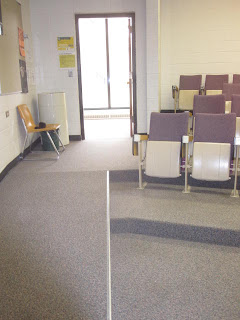Friday, May 31, 2013
graduation
One reason the blog has been a little bit quiet lately is because I just graduated from college. (Don't worry, there was an elevator to get downstairs!)
I'm taking some time off this summer, but I'll keep you posted on what's up next for me :)
Wednesday, May 1, 2013
how to make an accessible space: classroom edition
| photo: Seth Sawyers |
| Photo: Marijn de Vries Hoogerwerff |
- seats are attached and can't be moved
- seats have non-adjustable armrests, so people who require more room than the armrests allow won't be able to sit
- desks are attached to the seats, which is inconvenient for people who are left handed as well as for those who require more or less space between them and the writing surface. These desks are also usually a lot smaller, which means there is less room for assistive technology and other accommodations
- the vast majority of the seats are only accessible by stairs
- the doors don't appear to have buttons to open them
The barriers aren't only for people using wheelchairs. People with larger bodies or who are left handed might have to choose between sitting in an uncomfortable seat, or else asking to have a table and chair placed at the front of the class, where again they would be singled out and might have a harder time seeing. Somebody using crutches would also have a hard time with the stairs.
| Photo: velkr0 |
| photo: Rupert Ganzer |
| photo: Denise Krebs |
| Photo: James F Clay |
Here are some pictures I took of a lecture hall, and a few ideas to make it more accessible.
It has a ramp to get to the front of the classroom, which is a good thing. Unfortunately the desks and chairs are attached, and most of the rows of seats are only accessible by stairs.
You can see that there are some desks and chairs at the front of the room. People using wheelchairs could use these. But you can see that they would have to sit right at the front of the room, beside the professor, which is kind of awkward.
A better option might be to bring in a desk at the end of the row on the level of the exit. This way the person using the wheelchair could sit with their classmates. If it's not an option to renovate the whole room, even just removing one seat at the end of the row would give lots of space for a desk and chair.
Let's look at the first lecture hall again. What could be changed to make it more accessible, without completely renovating the whole room?
| Photo: Marijn de Vries Hoogerwerff |
- Install automatic door-opener buttons
- Remove a few of the seats in the front row and the back row, if there are exits there too, and bring in some tables/desks and chairs instead. Make sure the chairs are easy to move and don't have narrow armrests!
- If possible, turn one of the stairways into a ramp. You don't want it to be too steep. But this would let someone who uses a wheelchair and enjoys sitting in the back to use either the top or the bottom exit, and to speak to the professor after class.
Subscribe to:
Posts (Atom)




